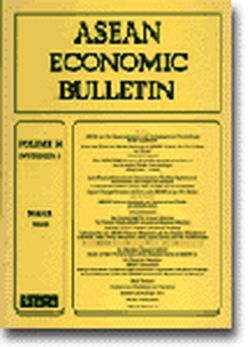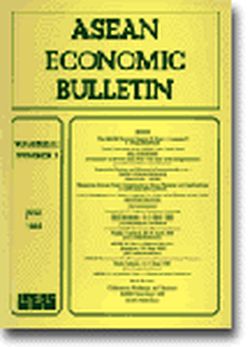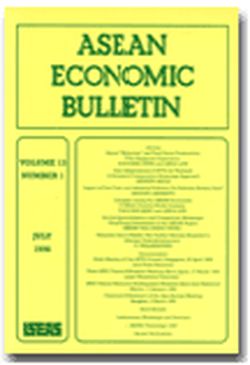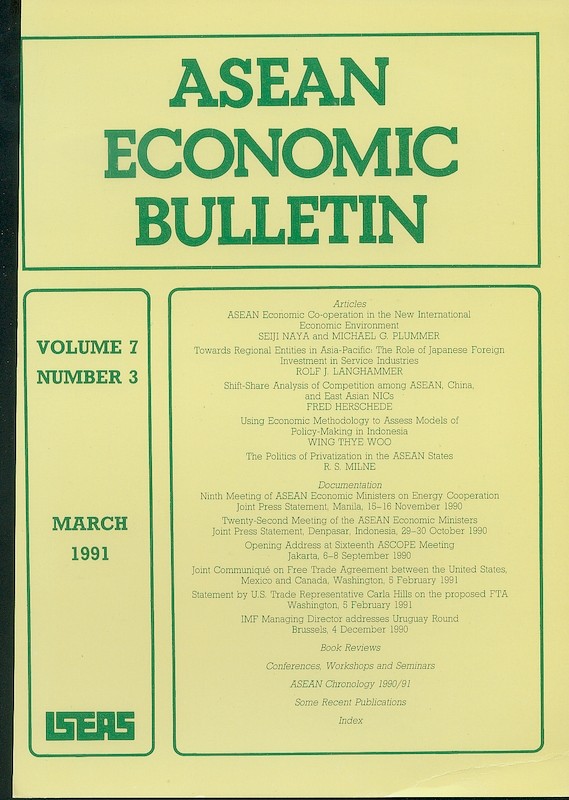ASEAN Economic Bulletin Vol. 14/3 (Mar 1998)

Date of publication:
March 1998
Publisher:
Institute of Southeast Asian Studies
Number of pages:
144
Code:
AE14/3
Contents
-
Preliminary pages, by Ross Garnaut, author
-
ASEAN and the Regionalization and Globalization of World Trade see abstractThe three decades of ASEANâs life have coincided with powerful tendencies towards regionalization and globalization of economic activity. This article (1) discusses these world-wide tendencies and their implications for ASEAN; (2) compares the dynamics of trade expansion within ASEAN with those of the European Union and the North American Free Trade Agreement territories; (3) discusses ASEAN in the context of the Asia-Pacific Economic Co-operation forum, and (4) argues that ASEAN is a successful example of economically efficient regional co-operation to achieve trade expansion.
-
Trade and Financial Market Reforms in ASEAN: Putting the Cart before the Horse? see abstractIndonesia, Malaysia, the Philippines and Thailand in general opened up their capital markets at a faster pace and before liberalization of trade. McKinnon (1991) and others have cautioned against such a sequencing of reforms as it may encourage the financing of investments in inefficient industries. Trade policy reforms adopted thus far have gone only part way towards creating an open and competitive system of trade. Government-sponsored efforts to promote heavy and technology-intensive industries have often relied on protection, monopoly, or hidden subsidies. These industries are unlikely to be able to successfully compete in an open competitive environment. Regional and global initiatives that advance the cause of real sector liberalization will force these industries to undergo restructuring or even to close down. Resistance to such changes is inevitable. Hence, there is a high likelihood that pressures will be placed on governments to adopt alternative forms of protection as trade liberalization takes place in the form of AFTA-CEPT and on a unilateral MFN basis. Global and regional economic institutions limit the degree to which discriminatory and non-transparent policies can be adopted. Yet such institutions provide only weak discipline over numerous trade practices, so there remain numerous unexploited protectionist measures available even as tariffs come down. Extending these arrangements to limit undisciplined use of contingent forms of protection, thus, is likely to become more important as traditional trade barriers continue to fall.
-
The AFTA-CER Dialogue: A New Zealand Perspective on an Emerging Trade Area Linkage see abstractIn 1994 the then Australian Prime Minister, Paul Keating, publicly floated the idea of linking two free trade areas, namely AFTA and CER. He made his announcement after consultation with ASEAN officials. Both Australia and New Zealand are interested in greater links between the two free trading areas but they are conscious that they must form the linkage at ASEANâs pace. To date the AFTA-CER dialogue has remained at the level of trade facilitation, through such means as information exchange on customs and standards, and has not yet moved into substantial trade liberation between the two areas. However, the AFTA-CER dialogue presents an important breakthrough for both free trade areas: negotiation and trade discussion between economic regions. The idea will only have currency if it contains mutual benefit to both sides of the negotiation.
-
Open Regionalism versus Discriminatory Trading Agreements: Institutional and Empirical Analysis see abstractThis article explores two approaches to regional integration: traditional free trade areas and customs unions under Article XXIV of GATT and the new concept of open regionalism introduced by the Asia-Pacific Economic Co-operation (APEC). Once the main features of open regionalism are described, we analyse the feasible extension of this model to other regions. Special attention is paid to the traditional framework of Article XXIV and the alternative ways of making regional agreements more open. Finally, empirical evidence is provided for two ongoing projects of regional integration: Mercosur and the ASEAN Free Trade Area (AFTA).
-
Export Competitiveness of China and ASEAN in the U.S. Market see abstractThis article provides a comparison of the changing patterns of export share, product mix, industry structure and export growth among China and ASEAN-4 (Indonesia, Malaysia, Singapore and Thailand) as exporters of primary commodities, labour-intensive goods as well as capital-intensive manufactures to their common U.S. import market. The degree of export rivalry or competition among China and ASEAN-4 in the U.S. market is examined by using a conventional shift-share methodology. Changes in ASEAN-Chinaâs relative real exchange rate, export composition, as well as changes in their trade patterns, insofar as they might have effects on the export shares of the ASEAN-4 and China to the United States, are considered. The study points unequivocally to some rivalry effects from China on the ASEAN-4âs exports to the United States. Some of the possible approaches to attaining a propitious outcome of the competition, and ways to ameliorate adverse effects of the rivalry are raised and discussed.
-
ASEAN, Labour Standards and International Trade see abstractThis article describes the issues arising from discussion on the ILO core labour standards in the global trading system and the attitude of ASEAN in this context. ASEAN has been opposing the proposals to link trade sanctions with core labour standards in the sense that such proposals are Trojan horses for protectionism. Some suggestions are provided to reconcile the opinion of the proponents with that of the opponents regarding this issue.
-
DOCUMENTATION: The Eleventh AFTA Council Meeting, Subang Jaya, Malaysia, 15 October 1997, Joint Press Statement, by Jai Sheen Mah, contributor
-
DOCUMENTATION: The Twenty-Ninth ASEAN Economic Ministers Meeting, Subang Jaya, Malaysia, 16 October 1997, Joint Press Statement
-
DOCUMENTATION: Special ASEAN Finance Ministers Meeting, Kuala Lumpur, 1 December 1997, Joint Ministerial Statement
-
DOCUMENTATION: Statement by the ASEAN Finance Ministers and the Finance Ministers of Australia, China, Hong Kong SAR China, Japan, Korea and the United States, Kuala Lumpur, 2 December 1997
-
DOCUMENTATION: Second ASEAN Informal Meetings of Heads of State/Government of the Member States of ASEAN, Kuala Lumpur, 5 December 1997, Press Statement
-
DOCUMENTATION: Joint Statement of the Heads of State/Government of the Member States of ASEAN on the Financial Situation, Kuala Lumpur, 15 December 1997, Joint Statement
-
DOCUMENTATION: ASEAN Vision 2020
-
DOCUMENTATION: ASEAN Economic Ministers Sign Protocol to Implement the Initial Package of Commitments under the ASEAN Framework Agreement on Services, Kuala Lumpur, 15 December 1997
-
DOCUMENTATION: Protocol to Implement the Initial Package of Commitments under the ASEAN Framework Agreement on Services
-
BOOK REVIEW: The Future of Capitalism: How Today's Economic Forces Shape Tomorrow's World. By Lester Thurow
-
BOOK REVIEW: Vikings and Mandarins: Sino-Scandinavian Business Cooperation in Cross-Cultural Settings, by Gerald Tan, contributor
-
Conferences, Workshops and Seminars; ASEAN Chronology 1997; Recent Publications; Index to Volume 14






